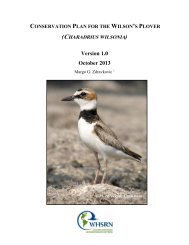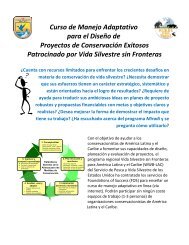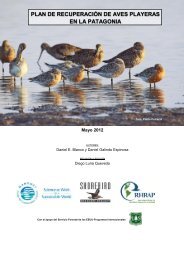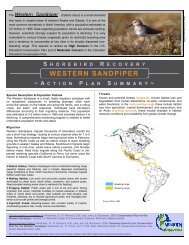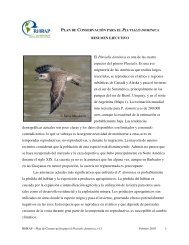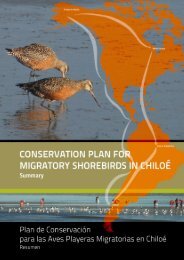Sanderling Plan - Western Hemisphere Shorebird Reserve Network
Sanderling Plan - Western Hemisphere Shorebird Reserve Network
Sanderling Plan - Western Hemisphere Shorebird Reserve Network
You also want an ePaper? Increase the reach of your titles
YUMPU automatically turns print PDFs into web optimized ePapers that Google loves.
EXECUTIVE SUMMARY<br />
The <strong>Sanderling</strong> (Calidris alba) is a small shorebird that breeds in the high arctic and<br />
migrates to temperate, tropical, and south-temperate beaches. In North America, the <strong>Sanderling</strong><br />
is classified as a Species of High Concern because of its significant population declines,<br />
widespread habitat loss, and the threats it faces during the nonbreeding seasons (migration and<br />
winter).<br />
The <strong>Sanderling</strong> has a circumpolar breeding distribution, however there is little<br />
morphological differentiation among breeding populations. In contrast, some differentiation of<br />
individuals occurs on the nonbreeding range. Only one race of <strong>Sanderling</strong> is recognized. This<br />
species uses three major migration flyways in the Americas: Pacific, Central, and Atlantic.<br />
The largest North American concentrations of <strong>Sanderling</strong>s occur during spring migration,<br />
where tens of thousands of birds gather on the mid-Atlantic coast (coastal beaches of Delaware<br />
Bay) and at shallow alkaline lakes in the Canadian Prairies (Saskatchewan). Other large spring<br />
concentrations also occur on the central coast of North Carolina (Dinsmore et al. 1998, Walters<br />
1984); on outer coastal sandy beaches of central Oregon, and southern Washington (Myers et al.<br />
1984b, 1984b); and in Alaska (Isleib 1979).<br />
Fall migration in North America is more protracted, extending from mid-July to late<br />
October (or November), with birds being generally less aggregated in space. However, some<br />
<strong>Sanderling</strong>s aggregate in Massachusetts (up to 17,000 individuals), New Jersey (8,000), Virginia<br />
(several sites with 17,000), Texas (8,400), and Washington (10,000) (International <strong>Shorebird</strong><br />
Survey database). Otherwise, <strong>Sanderling</strong>s spread out during fall, moving through important sites<br />
along the Great Lakes shorelines and all along Pacific and Atlantic coastlines. During winter,<br />
<strong>Sanderling</strong>s are dispersed, and a pronounced site fidelity in most locations and territoriality by<br />
many individuals likely influence population structure (Myers et al. 1988).<br />
<strong>Sanderling</strong>s need explicit conservation planning for several reasons:<br />
o Population declines;<br />
o Widespread habitat loss. Their principal habitat is wide-open sandy beaches and barrier<br />
islands, which are threatened by development and chronic human disturbance;<br />
WHSRN – <strong>Sanderling</strong> Conservation <strong>Plan</strong>, February 2010, v1.1 1





